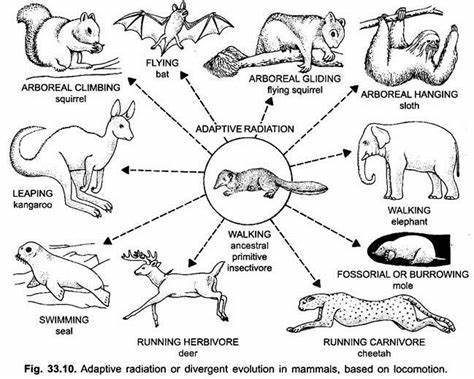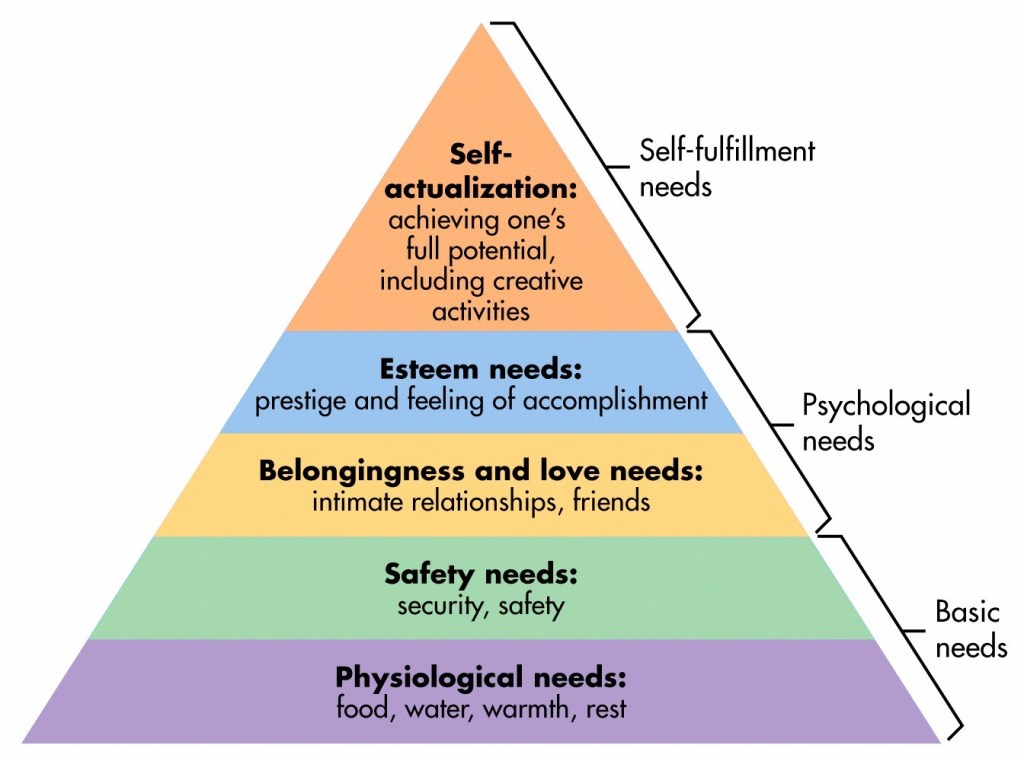Adaptive radiation may apply not only to genes, but also memetics and cognition.
In evolutionary theory there is a concept known as adaptive radiation. In essence, lifeforms take up a lot of niches. Each organism in an ecosystem plays some role in relation to the other organisms of the ecosystem. Some are prey, some are predators, and so on. When two animals compete for the same niche, one often goes extinct as it is outcompeted by the other. Eventually, a stable ecosystem is formed in which each species is helping to maintain a balance of the population of others. During these periods, evolutionary change is not as dramatic.
This all changes when a mass extinction occurs. During a mass extinction, a vast amount of species may quickly die out, like in the case of the dinosaurs. Suddenly a lot of niches are gone and a lot of ecosystems are left unbalanced. During these periods, new organisms will often evolve to occupy the lost niches. In the case of the lost dinosaur niches, the mammals took over. This ends up producing animals with strange and diverse traits very suddenly. For example, most animals looked like dinosaurs first, then suddenly the common animals have become strange mammals in the following time period. This sudden acceleration of speciation that occurs in order to fulfill the various empty niches is called adaptive radiation.

Adaptive radiation is a rapid increase in the number of species with a common ancestor, characterized by great ecological and morphological diversity. The driving force behind it is the adaptation of organisms to new ecological contexts.
From Events of Increased Biodiversity
I believe that this process is not at all limited to genetic evolution, but may also include memetic evolution and could even apply to cognition as well. To begin, let’s look at how culture evolves.
Consider: San Francisco, California was leading the world in technological development for a while. But why?
Memetic Adaptive Radiation

Let’s begin with how cultures seem to change. After some new land is found, culture adapts to fit the resources available. New foods may be incorporated into the diet of the people. New agricultural strategies may be found to match the climate of the region. New ways of life among the people of that society may form as their habits change to match the needs of optimum life in that region. New clothes may be born, new kinds of work may emerge, and so on.
At some point, the people of this society become very invested and distracted by the routines and loops that define their stable society. Different members of this society may fit various niches in a memetic ecosystem of harmony, at least if all goes well. Then, if outsiders join this society, they may introduce new memes that disrupt the repetitious flow of lifestyle that was in this ecosystem style stasis. This homeostasis of the memetic ecosystem dis-incentivizes progress because it is often designed to comfort the people with its stability, safety, and predictability, and progress will remove people from their cozy and safe lifestyles.
As an analogy, consider how new and old institutions differ. Often times a newer institution is more capable of adopting new technology, whereas older institutions have a pressure to maintain old infrastructure due to the costs of upgrading being more than the costs of maintaining old infrastructure. You could imagine old schools that still use old computers versus new schools that have adopted the use of the fanciest new technology. In a society, people will not so easily abandon their cultures and traditions, nor their jobs and lifestyles. Another example is the transition to automation, where many may lose their jobs, though the outcome is hypothetically better for us all because we would not have to spend our human energy. There is a comfort and even a pressure in holding onto our cultures and progress is a threat to this.
Luckily, humans were able to continue migrating through the world, allowing their culture to undergo memetic adaptive radiation in each new environment they came across. America was colonized, where unfortunately the natives were essentially culturally and physically destroyed. This allowed the English to undergo rapid cultural evolution in the presence of all this stolen land. This brings us back to California, the state of the Gold Rush, and one of the later colonized states. This state seems to be the epicenter of mass cultural evolution, where most of the major tech companies that currently dominate the influence of society and politics have originated from Silicon Valley. Hollywood and media have influenced a lot of national and even international culture as well.
Consider another case: the bubonic plague. After the bubonic plague, we were left with much of society and culture wiped out by the drastic and sudden changes to our lives. It is thought that this preceded and led to the Renaissance, a movement in which culture rapidly evolved. This could be an adaptive radiation induced by the extinction of many memetic lineages, one that is brought on not by travelling to a new region, but instead forced upon us by the death of our society. Fascinatingly, Isaac Newton did much of his work during the quarantine of a plague that was sweeping through England. So it seems that great societal change may emerge from a memetic adaptive radiation after great crises wreck our memetic ecosystem.
This is all very relevant to our time period because of the currently ongoing COVID-19 pandemic. We may find ourselves on the verge of the next Renaissance, despite that things seem so disastrous and stressful at the moment.
This paints a picture of memetic adaptive radiation on a societal scale, but what if this can happen within individuals as well?
Cognitive Adaptive Radiation

The psychedelic drugs like LSD, psilocybin, and MDMA are often touted for their ability to heal addictions (1) and treat traumas (2). This may be a kind of extinction of cognitive infrastructure that guides our behaviors, either to habitually chase rewarding stimuli in the case of addiction, or habitually respond to stress triggers and aversion in the case of trauma.
Addiction and trauma can both be viewed as extreme forms of Pavlovian conditioning, in which a behavior is paired with a rewarding or aversive stimuli. Rewarding stimuli functions to reinforce the behavior, to make us repeat the behavior in search of a rewarding stimuli. This is part of the story for addiction, in which a rewarding drug becomes reinforced and habituated. Aversive stimuli acts as a punishment, it induces fear and avoidance behaviors in response to the paired stimuli. This is trauma. We develop phobias, fear reactions, fight or flight states that respond to paired cues that originated from the traumatic event.
Psychedelics seem to treat both trauma and addiction, but it may not stop at that. We also observe increases in the trait known as openness to experience after use of psychedelics (3). This trait may be a response to the sudden freedom one has from habitual modes of cognition, a freedom from the cognitive infrastructures that held them back from exploring novel stimuli. The addictions may distract us from seeking out a more rewarding life, the traumas may scares us away from being exploratory in fears of becoming hurt again. So this newfound openness may be a relief from the memetic loops that were guiding daily behavior and in the sudden absence of these guiding cognitive loops, we may become free and desiring of exploration again.
Psychedelics may induce an adaptive radiation of the mind. Absolved of incessant ruminations, one’s mind may quickly evolve and become something new. This may be part of the story behind the observed increases in neurogenesis (4) and neuroplasticity (5) that occur with these drugs. The cognitive ecosystems may have many habit-niches that need filling which may drive one to seek out new experiences and growth. Enhanced creativity (6) may be a byproduct of this cognitive adaptive radiation. This may be observed as the rapid diversification of thoughts and ideas that emerge from cognitive ecosystems.
This mechanism may have even evolved as a response to novel environmental stimuli, in order to allow the organism to suddenly shift its’ behavior according to the new situation or environment. Once the situation has been explored, new habits and cognitive routines may emerge again, satisfying some set of mental niches in our cognitive ecosystems. Perhaps these niches may associate to Maslow’s Hierarchy of Needs:

Some people may be fulfilling their needs and cognitive niches with toxic habits and ruminations, like an invasive species of the cognitive infrastructure. The elimination of these invasive thought loops and memes may suddenly relieve people of the suffering they bring and also bring back the urgency to satisfy the needs that are suddenly rendered unmet. The newfound openness to experience is the craving to find new ways of satisfyingly these unmet needs, to find new cognitive species or memes that can lead to happier living.
Traumatic events and stressors may provoke the development of ruminations and habits that were adaptive during the stressful event, but even after these events pass, they may have costs and side effects that only serve to hold a person back from growth. These habits may have even been developed before the realization of their costs came into play, like in the case of addictions. One may not realize how bad a state of drug dependency is until it is too late and the costs of abandoning this habit are too great. In this way, the cognitive extinction event brought on by the psychedelic drugs may help in a new renaissance of the mind and allow new growth to emerge from the ashes, something I’ve dubbed The Phoenix Effect. In that project, you can explore how psychedelics may re-introduce a childlike state of mind or potentially even reverse the learning process.
In some sense, these layers of adaptive radiation are connected (kind of). The cognitive layer is a response to a new set of stimuli that requires a new set of adaptations and cognitive niches. The memetic layer is a cultural response to a new place of life that gives a society an urgency to adapt new lifestyles. The evolutionary layer is a bit more distinct, as it involves a species eventually evolving into many distinct species and humans do this culturally instead of genetically (that is not to say our genes are not continually evolving, but we are not speciating).
Mechanisms
Learning in the brain has sometimes been compared to the process of natural selection (7). In that chapter they discuss how associative learning can be compared to natural selection. The essay even describes the possibility that representations in the brain are replicated, like reproduction.
Pavlovian conditioning is a popularly studied form of associative learning that involves pairing a stimulus with a response so that the stimulus triggers behavioral responses. Associative learning doesn’t have to be behavioral, but can also be learned stimuli-stimuli patterns as well. The famous example would be Pavlov’s dog, in which dogs were trained to salivate at the ring of a bell. The bell sound was presented paired with food, which causes the dogs to salivate. Eventually, sounding the bell caused the dogs to salivate even without the presence of food.
The mechanisms of associative and Pavlovian learning are thought to involve dopamine, opioids, glutamate and others. In essence, glutamate may aide in the formation of memories and stimulate long-term potentiation, dopamine may tie into behavioral systems, while opioids seem to play the role of valence, as in what stimuli are rewarding or aversive. The endogenous opioids endorphins versus dynorphins may respectively play the role of ‘good’ versus ‘bad’ signals, for example. It is far more complex than this. To read in depth about associative learning mechanisms, check out Desummation.
The blocking effect is a phenomenon that occurs when one pair of stimuli-response patterns essentially blocks the formation of another pattern involving the same stimuli. In essence, the existence of previously learned associative patterns overrides the formation of new ones. In relation to Pavlov’s dogs, the bell could be rung along with a flash of light and food, but the light played alone will not be able to induce salivation, as the bell has taken precedence and the light is dismissed in this context. This seems to be more complicated, as new research shows that we do not yet understand the limits of this blocking process or which conditions elicit such effects (8).
You may start to see how this connects to the idea of cognitive niches and evolution now. If some cognitive niche, or associative pattern, is already filled, the cognitive pattern becomes competitive, much like how species are in ecosystems. It is as if we have formed one narrative for the apparent causal structure of temporal events that unfold before us and we stick to this perspective. Psychedelics may come in and shake up our sense of excessively defined causal inference, even down to the sensory level.
Psychedelics may allow one to re-interpret their understanding of the world.

But through what mechanisms?
It may come down to a disruption in opioid-related processes. In one study (9), fear (an electric shock) was associated to both a context and an auditory stimuli. Opioid blockade facilitated the association of fear to both the context and the auditory stimuli. The researchers did a second experiment in which the electric shock was paired with both a distinctive context and an auditory stimuli. This produced only associations with the distinctive context, not the auditory stimuli. The auditory association was ‘blocked’. The opioid blocker naloxone stopped this blocking effect, allowing the auditory stimuli to become conditioned with fear.
Psychedelics may facilitate an unblocking process by attenuating opioid related processes. It has been observed that LSD attenuates kappa opioid receptor mediated effects (10). There also appears to be opposites in major psychedelic related binding targets and opioid related binding targets. For example, morphine appears to reduce 5HT2a receptor binding (11). This receptor is though to underlie the psychedelic effects of the serotonergic psychedelic drugs such as LSD, psilocybin, and MDMA (12). The withdrawals of morphine appear to involve enhanced 5HT2a receptor activity (13). More importantly, blocking 5HT2a receptors appears to facilitate mu opioid receptor activity by increasing the number of mu opioid receptor containing neurons (14) and potentiate kappa opioid receptor activity (15). This suggests that the stimulation of 5HT2a receptors may decrease opioid related activity.
Opioid withdrawals have been suggested to resemble some of the effects of psychedelics, at least according to some on reddit. They noted overlaps between the two such as:
- Enhanced emotions, both positive and negative,
- Increased sense of “meaning”
- Music enhancement
- Bettered appreciation for the “little” things
- Extreme restlessness and feeling physically uncomfortable in general; this is actually worse for me when tripping than during the worst of my acutes (withdrawals).
- Increased sensations of temperature extremes (sweating and chills)
- Teary eyes and Runny nose
- Diarrhea
- Goosebumps
If true, this reduction in opioid activity may function similarly to the opioid antagonist naloxone, producing an unblocking effect in the conditioned mind. Though, the similarities between opioid antagonists and psychedelics aren’t total at all. Naloxone and psychedelics have been studied in the context of fear extinction, something that relates to treating trauma. Fear extinction is a kind of reversing of conditioned fear, although the fear conditioning can usually be restored by re-pairing the stimuli and the fear response again, often times faster than if one was associating them for the first time. Studies have found that psychedelics facilitate fear extinction (16, 17, 18), while naloxone actually inhibits it (19). This makes some sense, as naloxone and psychedelics may both help with addiction, but naloxone is not found to help with trauma, instead it actually seems to worsen it, at least acutely (20).
Opioid process inhibition may only account for a small portion of the effects of psychedelics on learning, there is also an observed increase in glutamate release through 5HT2a receptors (21), and glutamate stimulating drugs have been found to induce fear extinction (22). The psychedelic effects of these drugs likely involve many other mechanisms, so naloxone isn’t expected to be a similar drug in most other ways.
It is still unclear how the psychedelic receptors and the opioid mechanisms truly interact, as it is possible that many other mechanisms are involved in the serotonin mechanisms that alter the total effect observed, producing such differences between opioid antagonists and psychedelics.
Is it possible that the ongoing pandemic will extinct much of our culture and leave us in a new stage of memetic adaptive radiation? What kind of cultural evolution might emerge after COVID-19 is passed? I am curious what you can think of, let me know in the comments! If you are curious to read on how psychedelics might reverse learning through synaptogenesis and other mechanisms, check out The Phoenix Effect.
. . .
If you found this enjoyable, consider joining the Patreon!
Special thanks to the 13 patrons: David Chang, Jan Rzymkowski, Jack Wang, Richard Kemp, Milan Griffes, Alex W, Sarah Gehrke, Melissa Bradley, Morgan Catha, Niklas Kokkola, Abhishaike Mahajan, Riley Fitzpatrick, and Charles Wright! Abhi is also the artist who created the cover image for Most Relevant. Please support him on instagram, he is an amazing artist! I’d also like to thank Alexey Guzey, Annie Vu, Chris Byrd, and Kettner Griswold for your kindness and for making these projects and the podcast possible through your donations.
If you’d like to support these projects like this, check out this page.
If you liked this, follow me on
Find the amazing discussion for this post on Reddit:

Citations
1. Winkelman, M. (2014). Psychedelics as medicines for substance abuse rehabilitation: evaluating treatments with LSD, Peyote, Ibogaine and Ayahuasca. Current drug abuse reviews, 7(2), 101-116.
2. Davis, A. K., Averill, L. A., Sepeda, N. D., Barsuglia, J. P., & Amoroso, T. (2020). Psychedelic Treatment for Trauma-Related Psychological and Cognitive Impairment Among US Special Operations Forces Veterans. Chronic Stress, 4, 2470547020939564.
3. Andersen, K. A., Carhart‐Harris, R., Nutt, D. J., & Erritzoe, D. (2020). Therapeutic effects of classic serotonergic psychedelics: A systematic review of modern‐era clinical studies. Acta Psychiatrica Scandinavica.
4. Catlow, B. J., Jalloh, A., & Sanchez-Ramos, J. (2016). Hippocampal neurogenesis: Effects of psychedelic drugs. In Neuropathology of drug addictions and substance misuse (pp. 821-831). Academic Press.
5. Ly, C., Greb, A. C., Cameron, L. P., Wong, J. M., Barragan, E. V., Wilson, P. C., … & Duim, W. C. (2018). Psychedelics promote structural and functional neural plasticity. Cell reports, 23(11), 3170-3182.
6. Kuypers, K. P. C. (2018). Out of the box: A psychedelic model to study the creative mind. Medical hypotheses, 115, 13-16.
7. Fernando, C., & Szathmáry, E. (2010). Natural selection in the brain. In Towards a theory of thinking (pp. 291-322). Springer, Berlin, Heidelberg.
8. Skibba, R. (2016). Psychologists fail to replicate well-known behaviour linked to learning. Nature News.
9. McNally, G. P., Pigg, M., & Weidemann, G. (2004). Blocking, unblocking, and overexpectation of fear: a role for opioid receptors in the regulation of Pavlovian association formation. Behavioral neuroscience, 118(1), 111.
10. Sakloth, F., Leggett, E., Moerke, M. J., Townsend, E. A., Banks, M. L., & Negus, S. S. (2019). Effects of acute and repeated treatment with serotonin 5-HT2A receptor agonist hallucinogens on intracranial self-stimulation in rats. Experimental and clinical psychopharmacology, 27(3), 215.
11. Adriaens, A., Vermeire, S., Waelbers, T., Duchateau, L., Sys, S., Dobbeleir, A., … & Polis, I. (2010). Morphine decreases 5-HT2A receptor binding measured with SPECT in the canine frontal cortex. In 23rd Annual congress of the European Association of Nuclear Medicine (EANM 2010) (Vol. 37, No. suppl. 2, pp. S389-S389).
12. Ray, T. S. (2010). Psychedelics and the human receptorome. PloS one, 5(2), e9019.
13. Pang, G., Wu, X., Tao, X., Mao, R., Liu, X., Zhang, Y. M., … & Zhang, G. (2016). Blockade of serotonin 5-HT2A receptors suppresses behavioral sensitization and naloxone-precipitated withdrawal symptoms in morphine-treated mice. Frontiers in pharmacology, 7, 514.
14. Huang, J., Fan, Y., Jia, Y., & Hong, Y. (2011). Antagonism of 5-HT2A receptors inhibits the expression of pronociceptive mediator and enhances endogenous opioid mechanism in carrageenan-induced inflammation in rats. European journal of pharmacology, 654(1), 33-41.
15. Peiró, A. M., Climent, L., Zapater, P., Horga, A., & Horga, J. F. (2011). Ketanserin potentiates morphine-induced antinociception mediated by kappa-receptor activation. Pharmacological research, 64(1), 80-84.
16. Cameron, L. P., Benson, C. J., DeFelice, B. C., Fiehn, O., & Olson, D. E. (2019). Chronic, intermittent microdoses of the psychedelic N, N-Dimethyltryptamine (DMT) produce positive effects on mood and anxiety in rodents. ACS chemical neuroscience, 10(7), 3261-3270.
17. Feduccia, A. A., & Mithoefer, M. C. (2018). MDMA-assisted psychotherapy for PTSD: are memory reconsolidation and fear extinction underlying mechanisms?. Progress in neuro-psychopharmacology and biological psychiatry, 84, 221-228.
18. Catlow, B. J., Song, S., Paredes, D. A., Kirstein, C. L., & Sanchez-Ramos, J. (2013). Effects of psilocybin on hippocampal neurogenesis and extinction of trace fear conditioning. Experimental brain research, 228(4), 481-491.
19. Kim, J. H., & Richardson, R. (2009). The effect of the μ-opioid receptor antagonist naloxone on extinction of conditioned fear in the developing rat. Learning & Memory, 16(3), 161-166.
20. Hockings, G. I., Grice, J. E., Ward, W. K., Walters, M. M., Jensen, G. R., & Jackson, R. V. (1993). Hypersensitivity of the hypothalamic-pituitary-adrenal axis to naloxone in post-traumatic stress disorder. Biological psychiatry, 33(8-9), 585-593.
21. Moreno, J. L., Holloway, T., Albizu, L., Sealfon, S. C., & González-Maeso, J. (2011). Metabotropic glutamate mGlu2 receptor is necessary for the pharmacological and behavioral effects induced by hallucinogenic 5-HT2A receptor agonists. Neuroscience letters, 493(3), 76-79.
22. Walker, D. L., & Davis, M. (2002). The role of amygdala glutamate receptors in fear learning, fear-potentiated startle, and extinction. Pharmacology Biochemistry and Behavior, 71(3), 379-392.